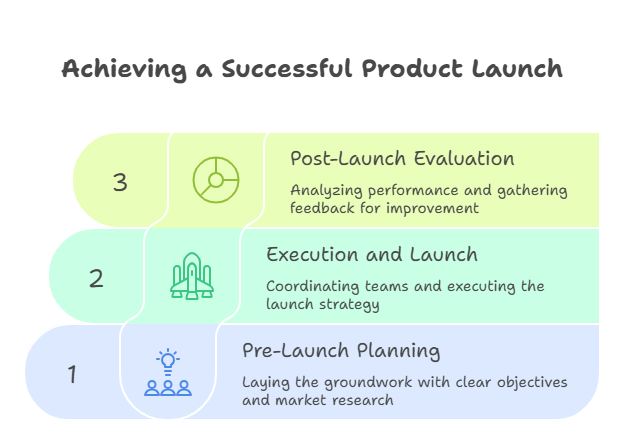How to Manage Product Launches: A Strategic Framework
Learn how to manage product launches effectively with our comprehensive framework covering planning, execution, and post-launch evaluation strategies.
Understanding Product Launch Management
Product launches represent critical milestones that can determine market success or failure. According to industry experts, successful launches require coordinating multiple teams including sales, customer support, product teams, and marketing. The product manager plays a crucial role in defining the go-to-market strategy and aligning cross-functional teams throughout the process.
Without proper planning, customer research, and market analysis, expecting positive outcomes becomes unrealistic. Effective launch management transforms what feels like a huge undertaking into a structured, manageable process that drives measurable business results.

Pre-Launch Planning Phase
The foundation of any successful product launch begins with thorough preparation. This phase typically consumes 60-70% of the total launch timeline and involves several critical components.
Define Clear Objectives and Goals
Start by establishing specific, measurable launch goals that align with broader business objectives. These might include target revenue figures, customer acquisition numbers, or market share percentages. The product manager must develop product roadmaps and set clear launch objectives that guide all subsequent decisions.
Conduct Market and Customer Research
Understanding your target audience and competitive landscape is non-negotiable. Successful launches require customer development, positioning, and messaging that resonates with your ideal customers. Utilize tools like ClipMind's AI Competitor Analyzer to systematically evaluate competitive offerings and identify your unique value proposition.
Develop Comprehensive Launch Documentation
Create a centralized source of truth that contains all launch-related information. As industry experts recommend, maintain a centralized documentation system and ensure all teams have access to the latest updates. Tools like Confluence can streamline the product launch plan process through templates, task assignments, and real-time editing capabilities.
Execution and Launch Strategy
The execution phase transforms planning into action through coordinated cross-functional efforts.
Implement Agile Project Management
Adopting agile project management practices allows teams to work in short iterations, continuously improving based on feedback. This approach increases your chances of delivering a high-quality product on time and within budget while remaining responsive to changing market conditions.
Coordinate Cross-Functional Teams
Product launches inherently involve multiple teams working together, including sales, customer support, product marketing, and event management. Establish clear communication channels and regular check-ins to ensure alignment across all departments. Effective internal communication becomes particularly critical during this phase.
Execute Go-to-Market Activities
Your launch strategy should encompass coordinated marketing campaigns, sales enablement, and customer education. The success of a product launch should be measured not just by its initial impact but by how well it integrates into ongoing customer relationships and sales strategies.
Post-Launch Evaluation and Optimization
The work doesn't end when the product goes live. Continuous improvement based on real-world data separates good launches from great ones.
Monitor Key Performance Indicators
Track predefined metrics against your launch objectives to measure success. Look beyond immediate sales figures to assess customer adoption rates, satisfaction scores, and product usage patterns. These insights help validate your initial assumptions and identify areas for improvement.
Gather and Analyze Customer Feedback
Systematically collect user feedback through surveys, support interactions, and usage analytics. This information provides invaluable insights for product iterations and future launch planning. Consider using tools that offer product concept testing and market research capabilities to continuously refine your offering.
Document Lessons Learned
Conduct a thorough post-mortem analysis to capture what worked well and what could be improved. This documentation becomes a valuable asset for future product launches, helping your organization build institutional knowledge and continuously refine its launch processes.
Common Challenges and Solutions
Even with careful planning, product launches face predictable challenges that require proactive management.
Resource Allocation and Timeline Pressure
Balancing ambitious launch goals with realistic resource constraints remains a persistent challenge. Implement effective project management practices to prioritize critical path activities and maintain momentum without burning out your team.
Cross-Functional Alignment
Ensuring all teams move in the same direction requires continuous effort. Establish a structured launch checklist and maintain regular communication rhythms to keep everyone aligned on priorities and progress.
Market Response Uncertainty
Despite thorough research, market response always contains elements of unpredictability. Build flexibility into your launch plans and prepare contingency strategies for different scenarios. The ability to pivot quickly based on early market signals often determines long-term success.
By following this comprehensive framework and leveraging tools like ClipMind for organizing launch information, product managers can systematically approach launches with confidence, increasing their chances of delivering products that resonate with customers and drive business growth.
 ClipMind
ClipMind